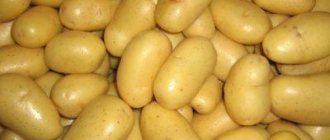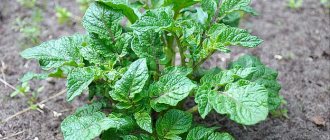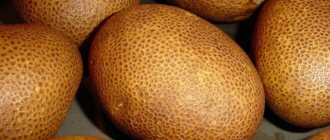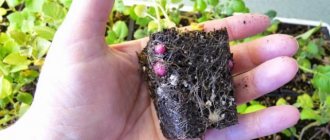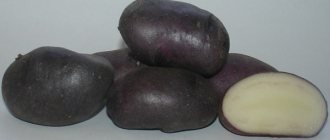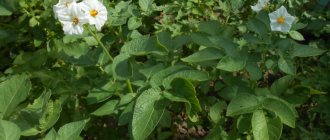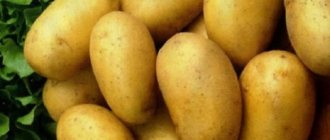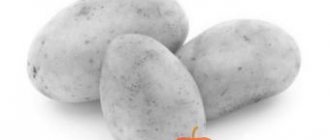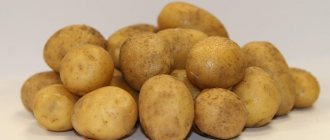Description of the potato variety Uladar
Breeders create, and farmers implement their work, thinking about the future of each new species. The high-yielding potato variety - on average up to 60 tons are harvested from one hectare - is notable not only for this indicator. Uladar is an early ripening plant. In regions with warm climates, gardeners manage to harvest twice a season and are very happy about it.
The ripening period for Uladara tubers ranges from 70 to 75 days, but the first harvest is dug up 50 days after germination. The percentage of starch content in root vegetables is quite high - 12-18. Despite the fact that Uladar potatoes are difficult to boil, gourmets appreciate them for their taste. By the way, on a five-point scale, taste is rated at 4.2 points. When fried, the ruler of Belarus has practically no equal. It makes excellent chips, makes delicious soups, adds it to salads, and makes potato pancakes.
The plant, which belongs to the intermediate type, has an erect trunk up to 60 cm high. The stems are thin, the leaves are narrow, brightly colored, slightly wavy at the edges. Their structure makes it easier to care for the plant. The main thing is that agricultural technicians and gardeners remember the density - no more than 500 tubers per hundred square meters. The flowers are purple, sometimes turning red. There are not many of them, and the fruits, as a rule, are set in small quantities.
Characteristics of the Uladar variety
This is a table variety, early ripening. It can be cultivated in many regions of the country. Potatoes have several features that distinguish them from other early vegetables.
- The starch content in the fruit reaches 12.5%, and the dry matter content is about 20%.
- On a 10-point scale, the variety is in 7th place.
- The productivity is very high.
- The tubers are perfectly preserved, without losing their turgor and taste.
- Can be grown 2 times per season.
The presence of 0.40% sugar in tubers allows us to consider it one of the most delicious varieties.
When planting tubers in the spring, it takes about 60-65 days until the products are harvested. This allows you to plant potatoes again in this area and get a second full harvest.
Advantages of potatoes
The highest quality characteristic of Uladar potatoes is the receipt of early product of technical ripeness. But he also has other good qualities.
- The tubers are almost the same size, oval-round in shape.
- During mechanical collection they are almost not damaged.
- More than 95% of potatoes can be sold through retail chains.
- The variety is resistant to many viruses and diseases.
When you dig up the tubers, you can immediately see that almost all the potatoes in the fruit nest are the same. Their average weight reaches 140g.
If planted correctly, in even rows, this variety can be harvested with a combine. All the potatoes in the bushes are located compactly, so they are not cut by the blades of the machine.
Uladar potatoes are not damaged by such viruses of nightshade crops as:
- common scab;
- fusarium rot;
- late blight of tubers.
Resistance to cancer allows you to reduce the level of chemicals when processing the above-ground parts of plants.
A pest that can cause damage to entire crops is the golden cyst nematode. It parasitizes the roots of nightshade plants. The variety is resistant to damage by these worms, but it is better not to plant it after tomatoes and peppers.
Disadvantages when growing
A significant disadvantage of this vegetable is its instability to rhizoctonia. The disease is called black scab due to the presence of black tubercles on the skin of the tubers. These pockets are full of fungal spores, which can survive in the soil for up to 3 years.
Like any nightshade plant, Uladar potatoes are loved by Colorado potato beetles. They can affect not only stems and leaves, but also tubers.
Uladar (potatoes): characteristics of tubers
Tubers of this variety can be distinguished by the following characteristics:
- oval round or slightly elongated shape;
- yellow peel (can be light or bright);
- the surface is smooth, there is a slight roughness, but it is almost not felt;
- the eyes are shallow, most often small and inconspicuous;
- the pulp has a pleasant creamy-yellow tint; during heat treatment it becomes rich;
- the percentage of starch in the pulp is 12-18%.
For comparison, the table below shows the starch content of other varieties that are popular among farmers and gardeners today.
| Variety | Starchiness |
| Laura | 15-17% |
| Sheri | 10-15% |
| Tuleevsky | 14-16% |
| Palm | 13-16% |
| Vega | 10-16% |
| Caprice | 13-17% |
| American | 14-18% |
What can I say, the creation of Belarusian breeders is superior in starchiness to many of its famous relatives.
Planting and growing potatoes
Planting Uladar potatoes differs little from planting other varieties. The area should be well lit by the sun. To prevent waterlogging of the soil, the depth of groundwater should not be less than 50 cm.
The variety is unpretentious to growing conditions; even with minimal care it is possible to obtain a bountiful harvest. Particular attention should be paid to proper planting, watering and timely weeding of the soil. We will consider the intricacies of planting and growing Uladar potatoes below.
Landing dates
The timing of planting Uladar potatoes depends on the composition of the soil on the site. Light sandy soil warms up faster in the sun in the spring, so tubers can be planted in it at the same time as early grain crops. Clay soil retains heat less well, so in areas with this type of soil, potatoes are planted a week later.
The optimal time for planting potatoes is the second half of May. The temperature on the soil surface during planting should be at least +15°C so that the planting material quickly germinates and does not rot.
Selection of planting material
Tubers intended for planting must be of high quality, free from mechanical damage and rot. Small fruits that have “eyes” on the surface are suitable. If only large tubers are available, then you can cut them into several parts so that each has at least 2-3 “eyes”.
Preparation of planting material consists of the following actions:
- Disinfection. To make the plant less susceptible to diseases and pest attacks, planting material is dipped in a weak solution of potassium permanganate for 20 minutes or treated with special chemicals (for example, “Prestige”).
- Germination. Before planting tubers in open ground, it is recommended to germinate them. To do this, 2 weeks before planting in the soil, the fruits are laid out in one layer in a well-lit room with an air temperature of about +15°C.
- Solanine production. You can keep the planting material in the sun for some time so that poisonous solanine forms in it. It will not allow early pests to harm the plant.
- Hardening. After the tubers have sprouted, it is recommended to take them out into the fresh air a few days before planting.
Soil preparation
The variety can be grown on any soil, but the crop bears fruit better in light and loose soil.
In addition, the following soil preparation work is carried out on the site:
- in the fall they dig up the garden deeply;
- before the start of winter, fertilize with organic fertilizers (manure, humus) to enrich the soil with nutrients;
- in the fall, mineral fertilizers are applied consisting of 40% nitrogen, 30% phosphorus and 30% potassium;
- Before planting potatoes, the soil in the garden is dug up again.
The Uladar variety gives a good harvest when planted in an area where legumes, perennial grasses or winter crops were previously grown.
Planting potatoes
When planting Uladar potatoes, you need to remember that the depth of immersion of planting material in the soil depends on the composition of the soil and the degree of its moisture. If the soil on the site is sufficiently moist, the tubers are immersed to a depth of about 8 cm, and in early planting periods - to 6 cm. In areas with low soil moisture levels, planting is carried out to a depth of about 12 cm.
- Dig small holes of suitable depth, placing them in rows. Leave a distance of 25–30 cm between holes, and about 60 cm between adjacent rows.
- Mix the soil dug out from the holes with compost or manure.
- Place the planting material into the holes, being careful not to damage the sprouts formed on the surface of the tuber.
- Sprinkle the holes with loose soil mixed with fertilizer.
- Carefully level the surface of the soil in the area with planted potatoes.
Timing and features of planting
When growing the Uladar variety on light sandy and sandy loam soils, planting germinated and processed planting material begins simultaneously with sowing early grains. On heavy and loamy soils, the planting dates for Uladar potatoes are shifted, and planting is carried out five days later. When planting and subsequent care of potatoes, you should remember:
- Early planting of potato tubers of the "Uladar" variety in areas with sufficient moisture is carried out with the material buried by no more than 5-6 cm. The use of ridge planting in leveled areas involves the deepening of prepared potato tubers by 7-8 cm. In areas with insufficient humidity, the tubers should be buried at 12-13 cm.
- Standard potato planting patterns: 700x200, 700x250, 700x300, 600x250, 600x300 and 600x350 mm. Potato plantings should be kept as clean as possible by carrying out timely weeding. During the growing season, it is necessary to carry out two harrowings and the same number of inter-row treatments.
It is important to maintain the soil in a consistently loose state until harvesting.
- Watering of Uladar potatoes is regulated depending on the type and condition of the soil.
- If necessary, several planting treatments are carried out during the season against major pests.
- Harvesting of early-ripening potatoes of the Uladar variety is carried out at the stage of the presence of green tops, which allows you to collect the maximum number of highly marketable and storageable tubers. Standard mesh bags in which the tubers are well ventilated are considered to be very convenient containers for harvested potatoes.
History of variety development
The birthplace of the Uladar potato is Belarus. This is a relatively young variety, it was bred by breeders Makhanko V., Piskun G., Vologdina L. and Kolyadka I. in the Belarusian Republican Unitary Enterprise “Scientific and Practical Center of the National Academy of Fruit and Vegetable Sciences”. Potatoes were developed by crossing the Zhivitsa and Kolya varieties with each other. In 2008, having passed all the tests, the variety was included in the State Register of Belarus and was allowed for mass distribution. It was recommended for cultivation in Vitebsk, Mogilev, Gomel, Minsk and other regions. In 2011, Uladar was included in the Russian state register. On a 10-point scale of taste properties in Russia it was assigned a solid 7. Today it is grown not only in Russia and Belarus, but also in all CIS countries.
Potato tubers Uladar
How to grow
The variety can grow on any type of soil. But the plant is demanding on the amount of nitrogen and phosphorus; there must be a lot of potassium in the soil.
Important! Potatoes should be planted in sandy and sandy loam soil earlier than in loamy soil. With a lack of nutrients and microelements, the quantity and quality of the crop will become low.
Dates, scheme and rules of planting
Before planting, potatoes are selected, removing rotten and disease-damaged specimens. Next it is germinated . To do this, the potatoes are placed in a dark, warm room with a temperature of +13…+15°C. After a couple of weeks, the fruits are examined for the presence of sprouts. Before planting, seed potatoes are kept in a solution of potassium permanganate.
The effect of massage on the human body
If there are a lot of sprouts, then the tuber is cut into 2-3 parts. Each part must be at least 35 g, otherwise the sprout will not be able to sprout from the ground.
Planting is carried out in May, when the soil warms up to +8...+1°C at a depth of at least 6-7 cm.
At the same time, mineral mixtures are added to the soil and fertilized with compost. On the day of planting, it is advisable to treat the tubers strictly according to the instructions with pest control agents - “Prestige”, “Commander”.
Next steps are:
- Make holes or furrows of suitable depth. The planting pattern is traditional. The width between tubers is at least 35 cm, between rows - 60-70 cm.
- Place the seed potatoes, sprouts up, in moist soil to a depth of 8-10 cm. If the soil is clayey, then 6-7 cm is enough. In areas with low humidity - 12 cm.
- Cover the holes with soil mixed with fertilizer.
- Carefully level the surface of the soil with the planted potatoes.
You can add wood ash and onion peels to the soil along with the tubers - this will repel pests. Nitrogen-containing mixtures should be excluded during this period.
Care
For a high yield, the following agrotechnical measures are necessary:
- watering;
- weeding;
- loosening and hilling;
- application of fertilizers.
Typically, 3-4 waterings are carried out per season. But this depends on climatic and weather conditions, the condition of the bushes and soil.
The soil needs to be periodically loosened and weeds removed. Loose soil better saturates the roots with oxygen and allows rain moisture to pass through.
Hilling of the bushes is carried out when the plantings reach a height of 10 cm. The procedure is repeated before flowering. During this time, the plants grow up to 20 cm. Hilling is carried out for the third time when the potato bushes become about 30 cm high. The mounds with soil are made at least 20 cm high.
After planting, the plant needs fertilizers with potassium and phosphorus - “Superphosphate”, “Kalimagnesia”. It is enough to apply them several times during the season.
Important! Be careful with nitrogen-containing fertilizers. A large amount of nitrogen negatively affects the harvest.
Nuances of cultivation and possible difficulties
The Uladar variety is not demanding on moisture, but prolonged drought will negatively affect the harvest.
If you do not hill up the bushes, the yield will also decrease. An important feature of this variety is the intensive formation of tubers in the first half of the growing season. At this time, the crop must be actively fed.
The variety is immune to some potato diseases:
- potato cancer;
- potato nematode;
- common scab;
- fusarium rot;
- Alternaria blight.
But the danger for tubers is rhizoctonia, due to which you can lose 30% of the seedlings. For prevention, root crops are treated with the Maxim fungicide before planting.
Attention! The variety has a tendency to curl leaves and rot. If found, treat the foliage with a solution of potassium permanganate.
Of the pests, the main enemy is the Colorado potato beetle. In the middle of tuber ripening, the number of insects increases sharply. If there are a lot of plantings, you will have to treat them with insecticides. Spraying is carried out according to the instructions on the package. The drugs “Aktara”, “Kinmiks”, “Bankol” are suitable.
Important! The bushes are treated at least 30 days before harvest.
Disease resistance
Potato "Uladar" its characteristics, taste, productivity, and resistance to diseases make the variety desirable for growing in the gardens of both summer residents and amateur vegetable growers.
Potatoes are not susceptible to nematodes and canker and are moderately susceptible to late blight microscopic fungus and leaf curl. Unfortunately, at the moment there is not a single variety that is completely resistant to late blight.
Therefore, vegetable growers continue to strictly follow the recommendations of experts and regularly treat potato plantings with antifungal drugs.
Wrinkled and striped mosaics also cannot overcome the selection novelty of the Belarusians.
Uladar potatoes certainly deserve attention. By improving the structure of the soil and its nutritional value, selecting new varieties, you can achieve extremely high yields of tasty potato varieties, including “Uladar”.
zelenj.ru
Protection from diseases and pests
After the first shoots, during weeding or hilling, the plants are inspected for diseases. If leaf curling is detected, the bushes are treated with a solution of potassium permanganate or peroxide, however, due to the characteristics of the variety, such problems arise quite rarely.
The fight against the Colorado potato beetle when growing the Uladar variety should be systematic. A few days after hilling, it is necessary to collect pests so that the beetles do not lay eggs. Next, if there is a large accumulation of the Colorado potato beetle, the potatoes are treated with special means.
The procedure is performed according to the instructions on the package. Typically, this remedy lasts 20-30 days, after which the bushes are treated again due to their low resistance to parasites. Bushes should be treated with different means, based on different active ingredients, due to resistance to drugs that occurs in Colorado beetles.
ferma.expertt
Peculiarities
The Uladar potato gained popularity due to its characteristic qualities:
- Precocity. These potatoes are early ripening varieties; the period from planting to ripening ranges from 70 to 75 days. The first harvest of young potatoes is obtained 45 days after planting. This variety can bear fruit twice per season;
- Productivity. This quality is the main distinguishing feature of Uladar. During the first digging, the yield is 35 tons per hectare, the yield of the second digging reaches from 56 to 60 tons;
- Drought resistance. Potatoes do not tolerate short dry periods well. During prolonged drought, not too much watering is required;
- Soil requirements. Uladar has excellent performance when grown on medium and light soils. Can also be grown in other types of soil;
- Application. It is a high-quality table variety, suitable for long-term storage. Has excellent keeping quality from 93 to 95%;
- Taste properties. On a five-point scale it receives a rating of 4.2. When cooking, the pulp is not boiled, maintaining its elasticity;
- Resistance to mechanical stress. During harvest, 96% of root crops do not lose their marketable appearance;
- Tolerance to diseases. Highly resistant to potato blight, potato cyst nematode, banded and wrinkled mosaics. It has average resistance to late blight of tops and tubers, and leaf curl virus.
Video review of potato varieties: Briz Volant, Jelly, Zekura Rosalit and Uladar:
Productivity
"Uladar" gained its popularity due to its high yield. The first young potatoes can be harvested in sufficient quantities as early as mid-June. This is more than a kilogram per bush and from 16 to 35 tons per hectare.
Mature potatoes are harvested a little more than three months after sowing. Average potato harvest per hectare ranges from 40 to 55 tons.
The record potato yield per hectare was more than seventy tons. In the southern regions, it is not uncommon for the crop to be harvested twice a year.
This adds to the popularity of the variety, which is distinguished by excellent productivity, ease of care and resistance to diseases and pests. Its excellent taste makes it a desirable dish on any table.
Advantages and disadvantages
The Uladar potato is considered the most promising among other varieties bred by Belarusian breeders. Why? Let's list its main advantages?
- Super early ripeness. The full growing season lasts 70 days, but you can start enjoying young tubers already on the 45th day from the moment they are planted in the ground.
- Double harvest. In the southern part of the country, an attempt to plant Uladar twice in one season will be successful; a high yield is guaranteed both after the first and after the second planting.
- High yield. This is perhaps the most important distinguishing feature of this variety. Under favorable conditions, up to 60 tons of high-quality potatoes can be harvested per hectare, and this is not the limit. A record was recorded when Uladar produced as many as 71 tons of selected potatoes from one hectare!
- Unpretentiousness. The variety easily tolerates periods of summer heat; it is completely undemanding to the soil. But still, preference should be given to soils with light or medium texture; on heavy ones, the yield will noticeably decrease.
- Application. Uladar is considered a high-quality table variety. It is excellent at transporting over long distances, so it is often grown for export to other countries. These potatoes also store well and can be used until the next harvest.
- Excellent taste. Potatoes have a pleasant taste and aroma and do not become soggy when cooked. If you fry the pieces in olive oil or goose fat, they will acquire a crispy crust, while the flesh will remain tender, almost melting in your mouth.
- Resistance to certain diseases. Uladar rarely suffers from potato cancer, is not afraid of nematodes, and is not afraid of wrinkled and striped mosaics.
The only significant drawback of the variety is that it is sometimes affected by late blight (both tops and tubers); in addition, in dry conditions the leaf curl virus can appear. In all other respects, this potato does not cause any complaints.
Reviews
Karina
A few years ago, our neighbors in the country gave us a bucket of Uladar potatoes to plant as a test. We had never heard anything about this variety before. We decided to try to grow it. We were very pleased with the result. The harvest ripened very early. That's why we had new potatoes on the table when others only dreamed of them. Potatoes have excellent taste. The tubers do not disintegrate during cooking and have a pleasant yellow tint. Very good harvest. The variety is stored for a long time. The main thing is that Uladar does not require any special care.
Tatiana
This potato variety has been growing on our site for 4 years now. We can't get enough of him. The harvest is high, Uladar ripens very early. The tubers have a very good taste. You can prepare a variety of dishes from it. It does not turn black when cooked, but has a yellow tint. I don’t know a variety that tastes better than Uladar. This year we decided to do an experiment. We planted a dozen bushes in a greenhouse. During the season we harvested twice. Our family is simply delighted with Uladara. I recommend everyone to pay attention to this variety. You will not regret it. I am especially pleased that it does not require any special care.
Advantages and disadvantages
All plants are viewed from this angle; the Uladar potato is no exception. Agronomists believe that the future lies with varieties such as Uladar.
Among the advantages are:
- Unpretentiousness to the soil. However, in light or medium soil it feels better, indicating an increase in the number of tubers in each hole. In heavy soil, yields are noticeably reduced.
- One of the important advantages is resistance to traditional potato diseases.
- Given their ability to travel long distances, potatoes are specially grown for export.
There is no need to list the disadvantages of potatoes for a long time:
- Tendency to late blight.
- Mandatory watering during dry periods.
- The need for insecticides in the fight against the Colorado potato beetle.
Collection, storage and use of crops
Potatoes are harvested after the tops wither, the leaves turn yellow, but the stem remains green. It is at this time that potatoes have the best commercial quality and keeping quality.
How to deal with mealybugs on orchids, ficus and other indoor plants at home?
Potatoes are dug up with a shovel or pitchfork. This is done carefully so as not to damage the tubers. If the weather is dry and sunny, the harvested crop is laid out on a flat area of the garden and dried in the sun.
Then the tubers are placed in boxes and taken to a place where the sun's rays do not pass through - for example, a garage or barn. Here the potatoes need to be spread out again and held for a while so that they dry out better and excess moisture is removed. Only after this the tubers are sent for storage in the basement or cellar.
The variety is well stored until next year with almost no loss . It is important that the storage room has a low temperature, +2-3°C, and a working ventilation system.
Uladar is used for frying, baking and boiling. The potatoes do not boil over and have a pleasant taste and aroma.
Farmer reviews
There are many positive reviews from gardeners about this variety. Its high yield and excellent taste are often noted. But there are comments that potato bushes are highly susceptible to attacks by the Colorado potato beetle.
Eduard, Kopeysk: “I’ve been growing this variety for the fifth year in a row. I don’t even think about changing it to another. The yield is good, there are no problems with care. The only negative is that the Colorado potato beetle loves to eat leaves. We have to tinker with the selection of protective equipment.”
Marianna, Kamyshlov: “I consider Uladar one of the best varieties. It produces a large harvest. True, it doesn’t make a very good puree. We fry it or add it to soup. The tubers are well stored and have an excellent presentation, as in the photo on the Internet.”
Vladimir, Noyabrsk: “For me, Uladar is a gift of fate. I live in the northern zone, and winter comes early here. I want to plant potatoes, but they don’t have time to ripen. But now there are no problems. The variety is early ripening, we harvest before the cold weather.”
Diseases and pests
According to the description of the Federal State Budgetary Institution State Varietal Commission, the Uladar variety of potatoes is resistant to the following diseases and pests:
- potato cancer;
- golden potato cyst nematode;
- wrinkled and striped mosaic.
According to the originator of the variety, resistance to late blight of tubers and tops is average, as is resistance to leaf curl virus.
Uladar potatoes can be affected by rhizoctonia (black scab), as a result of which up to 1/3 of the seedlings can be lost. To prevent the disease, it is recommended to treat tubers with Maxim or another contact fungicide before planting.
Of all the possible pests of Uladar potatoes, the Colorado potato beetle comes first. In the middle of the ripening period, the number of larvae and adults on the tops increases sharply, and if insecticides are not used in time, you can lose the harvest.
Characteristics and description
The Uladar variety was bred in Belarus in 2008. A team of breeders from the Scientific and Practical Center for Potato and Fruit and Vegetable Growing worked on its creation. To obtain a new type of potato, scientists crossed the Zhivitsa and Kolya varieties. As a result of crossing, a new variety was obtained, characterized by early ripening and excellent taste of tubers.
Did you know? The variety was named after the film “The Lord of the Rings,” which was released shortly before the introduction of a new type of potato. Translated from Belarusian the word “uladar”
-
lord.
Today the variety is successfully grown in Ukraine, Russia, Belarus and Moldova.
Description of the Uladar variety:
- The bushes are about 60 cm high and have thin stems, semi-erect and compact.
- The leaves are medium in size and have slightly wavy edges. Painted in rich green color.
- Blooms with medium-sized inflorescences. Each contains about 10 small red-purple flowers.
- Early ripening, the first digging can be done 45 days after emergence.
- The fruits are large, oblong. The peel is thin and smooth, yellow in color. The weight of one fruit reaches 140 g.
- The pulp is light yellow, does not change color during heat treatment and has an excellent taste.
- The tubers are well stored and do not lose their attractive presentation after transportation and are resistant to mechanical damage.
- Immunity to cancer, late blight, wrinkled and striped mosaic, potato golden nematode, common scab. Can be affected by leaf roll virus, rhizoctonia and Colorado potato beetle.
Reviews about the variety
Most people value Uladar potatoes for their excellent taste, which is preserved not only boiled, but also fried. Due to its precocity and attractive appearance, it is in consumer demand. It is often grown by gardeners for sale. According to their feedback from farmers, the variety is completely problem-free because it ripens on all types of soil.
The Uladar potato variety, developed by Belarusian breeders, is becoming increasingly popular in the post-Soviet countries. The variety does not require special conditions for maintaining potato beds, and is also resistant to pests and diseases.
Reviews from gardeners
The table variety “Uladar” attracts many with its excellent taste, which the tubers retain not only in soups, but also when fried. Due to its early ripeness and visual attractiveness, the Uladar potato variety is in great demand among buyers and is often grown by gardeners for sale. The variety is characterized by most summer residents and small farmers as absolutely problem-free. It grows on any type of soil. The variety "Uladar" is translated into Russian as "Lord", which largely determines the quality characteristics of this variety. It has already been noted that potatoes of this variety are, first of all, very demanding on the quantitative composition of nitrogen in the soil, and only then on phosphorus. It is recommended to feed the plant with potassium in the second half of the growing season.
Caring for potato beds
In order for the yield of the Uladar variety to be high, it is necessary to make some efforts to care for the crop plantings. The soil needs constant loosening and removal of weeds. Loose soil allows air and rain moisture to pass through better. Bushes need to be hilled 2 or 3 times per season. Once the plants reach a height of 15 cm, use a hoe or hoe to form piles around the tops. Thanks to this agricultural technique, the stems will not spread across the surface of the soil, they will grow upward. Repeated hilling will allow the root system to fully develop and form a larger number of tubers.
The variety tolerates drought normally, but during the period when the buds open, the soil should not be allowed to dry out. It is at this moment that the nodules begin to actively grow, so they need more moisture and nutrients. It is recommended to combine additional watering with the application of mineral fertilizers.
How long does it take for Uladar potatoes to grow? The first tubers can be dug up already on the 40th day from the moment of planting. Young potatoes with thin skin are very tasty and healthy. After another 20 days, the potatoes will approximately double in size. By this time, the tops will begin to turn yellow and wither, which is a sign of full maturity. Now you can safely cut off the above-ground part and start harvesting potatoes a week after this procedure.
Reviews from gardeners
Albina
Last spring I bought a bag of Uladara to plant for testing. The tops sprouted very early, literally within a week, and we already dug up the tubers themselves at the end of July. The vegetables taste excellent, and their ripening time is very pleasing. I left the seed potatoes for planting next year. I'll definitely plant more.
Hope
We have been growing Uladar for three years in a row. During this time, the yield has never dropped below 300 centners per hectare, but we regularly take care of the plantings: we weed several times a month, and hill up 2-3 times during the summer. As a top dressing, I water the soil with liquid mullein, even before the tops bloom. I dilute 1 kg of manure with 10 liters of water and pour it into the soil. The tubers turn out smooth, without flaws and are suitable for any purpose.
Agricultural technology
A month before planting, seed potato tubers are sorted out, discarding those with noticeable damage. Healthy Uladar potato planting material is laid out in boxes in 2-3 layers for germination and placed in a bright room. At temperatures above 14-15 oC, vernalization of early potatoes begins - light sprouts appear. Directly on the day of planting, some farmers treat the sprouted tubers with drugs against Colorado potato beetles: “Prestige”, “Commander”, and growth stimulants: “Zircon”, “Mival”, “Gibbersib”. Spraying is carried out following the instructions for the chemicals.
Landing
When the soil warms up to +7 °C in May to a depth of 10 cm, early Uladar is planted.
- Potatoes are deepened into the soil by 8-10 cm;
- On clay soils, tubers are planted at 6-7 cm;
- They adhere to the generally accepted planting scheme for the variety: row spacing 60 cm, distance between bushes 35 cm.
Care
To ensure that the taste and yield of Uladar potatoes meet the specifications, a lot of attention is paid to it.
- The soil is regularly loosened and weeds are removed;
- The bushes are hilled 2-3 times, starting from the moment the plants rise 15-20 cm;
- Drought before flowering, when tubers begin to form, is especially dangerous for early potatoes. If there is no rain, you will have to water the area with Uladara plantings;
- The potato variety will respond gratefully to watering if moisture penetrates its smallest roots to a depth of 20-30 cm.
Planting and caring for Uladar potatoes
The Uladar variety is not particularly demanding in care, which is why it is loved by many owners of large agricultural farms. However, knowing the nuances of its agricultural technology, you can significantly increase productivity.
Selection and preparation of a landing site
Potatoes of the Uladar variety can be successfully grown on any soil, however, they will reveal their full potential on light and medium soil in terms of particle size distribution. It is best if it is sandy loam soil, black soil and peat. It is not recommended to plant potatoes in lowlands and places where water stagnates.
In autumn, the area under the potato field is dug up, the layer is turned to a depth of 25-28 cm, and organic fertilizers are applied. In the spring, compost or manure is added to the soil; if this was not done in the fall, the soil is loosened to a depth of 12-15 cm, enriching it with oxygen. Immediately before planting, the area is dug up using a shovel and leveled with a rake.
Attention! The best predecessors of potatoes are considered to be grain crops, forage grasses, flax, lupine, and legumes.
Preparation of planting material
A month before planting, seed potatoes are sorted, rejecting tubers with mechanical damage, rot and similar defects. Selected root crops are placed in boxes in 2-3 layers for vernalization. The container with potatoes is placed in a warm and well-lit place with a temperature of 14-15°C. Soon light shoots will begin to appear on the tubers.
Immediately before planting in the ground, you can treat seed potatoes with insecticides against the Colorado potato beetle (Prestige, Commander), as well as growth stimulants.
Landing rules
Early Uladar potatoes begin to be planted in May, when the soil temperature is more than 7-10 ° C at a depth of 10 cm. Tubers are placed in holes 8-10 cm with sprouts up, in the case of heavy clay soils - 6-7 cm. Distance between rows – 60 cm, between neighboring bushes – 35 cm.
Watering and fertilizing
Uladar tolerates short-term drought, but if it is prolonged, it needs watering. Moist soil is especially important in the period before flowering, when tubers are being laid. Uladara plantings must be watered to a depth of at least 20-30 cm so that the moisture reaches the deepest roots. One watering every 2-2.5 weeks throughout the growing season is enough.
Uladar potatoes are characterized by increased tuberization in the first half of the growing season. Regular application of mineral fertilizers at this time will help the potato bush to form a larger number of tubers and qualitatively increase their mass.
Attention! Potatoes are watered in furrows so as not to wash away the soil around the tubers.
Loosening and weeding
After planting, Uladar potatoes especially need oxygen. Knowing this feature, you need to carefully plow the soil between the rows as soon as the first shoots appear. During the season, you should regularly weed the plantings and loosen the soil.
Hilling
The first time the potatoes are hilled up when the height of the bush is 5-8 cm. Wet soil is raked from the rows to the bushes, first on one side and then on the opposite side. It is not recommended to hill up in the heat or in the sun, since warm, poured soil negatively affects the stems and their development. It is best to hill up after rain, early in the morning or late in the evening.
The second time hilling is carried out when the potatoes reach a height of 15-20 cm, before flowering. The height of the hill should be at least 15-18 cm. The third hilling is carried out when the plant height is 25-30 cm, the height of the embankment is 17-20 cm.
Comment! Without hilling, Uladar's yield will decrease by 20-25%.
Fertilizers
You can support the fruitful potential of potatoes by applying fertilizers to the plot in the fall, early spring, or by feeding the crop itself.
Site preparation
The area for potatoes has been prepared since autumn. Without having time to fertilize the site in the fall, you can provide the early potato variety Uladar with the necessary substances before planting. Choose one of the options:
- Organic fertilizers will enrich the soil and guarantee a harvest. Application rates for fresh manure differ for different soil types. On heavy soils, 30 kg of organic matter per 1 square meter will be sufficient. m, sand ones require 40-60 kg. If humus is used, take a third of the above volumes;
- Superphosphate and potassium sulfate are also added to organic matter;
- In early spring, during the first cultivation of the soil, mineral preparations are scattered on the ground, then they are buried deep: 2 kg of potassium sulfate and 1 kg of double superphosphate are added per hundred square meters;
- They are also fertilized with phosphorite type nitrophoska. Sulfuric acid-type nitrophoska is added to sandy and soddy-podzolic soils.
Plant nutrition
There are many different ways to fertilize potatoes during the growing season.
- When planting early Uladar potatoes, put 0.5-1 liters of humus and a handful of wood ash in the hole, and on heavy soils add a handful of sand. The soil will become looser, and it will be convenient for tubers to grow in such soil. In addition, the sand will to some extent protect the potatoes from wireworms;
- A month after planting the Uladar potato variety, 20 g of superphosphate, 10 g of potassium salt and urea are added per square meter;
- For low shoots and in the bud formation phase, potatoes are fed leaf by leaf with superphosphate. First, 3 tablespoons of granules are dissolved in 0.5 liters of boiling water. After a day, 0.3 liters of the extract are mixed with 10 liters of water and sprayed onto the plantings;
- During flowering, they are fertilized with urea, also by foliar feeding: 50 g of the product are diluted in 10 liters of water. Consumption rate – 3 liters per 10 sq. m;
- After flowering, they are fed with magnesium and boron - the drug "Mag-Boron". Dilute 20 g in a bucket of water. Fertilizer improves the taste of any potato, including Uladara;
- Good results and easy use with ready-made products - “Impulse Plus”, “Surprise”, “Ideal”, humates.
